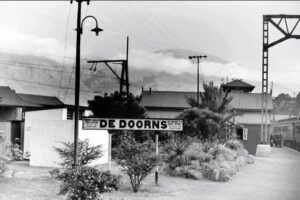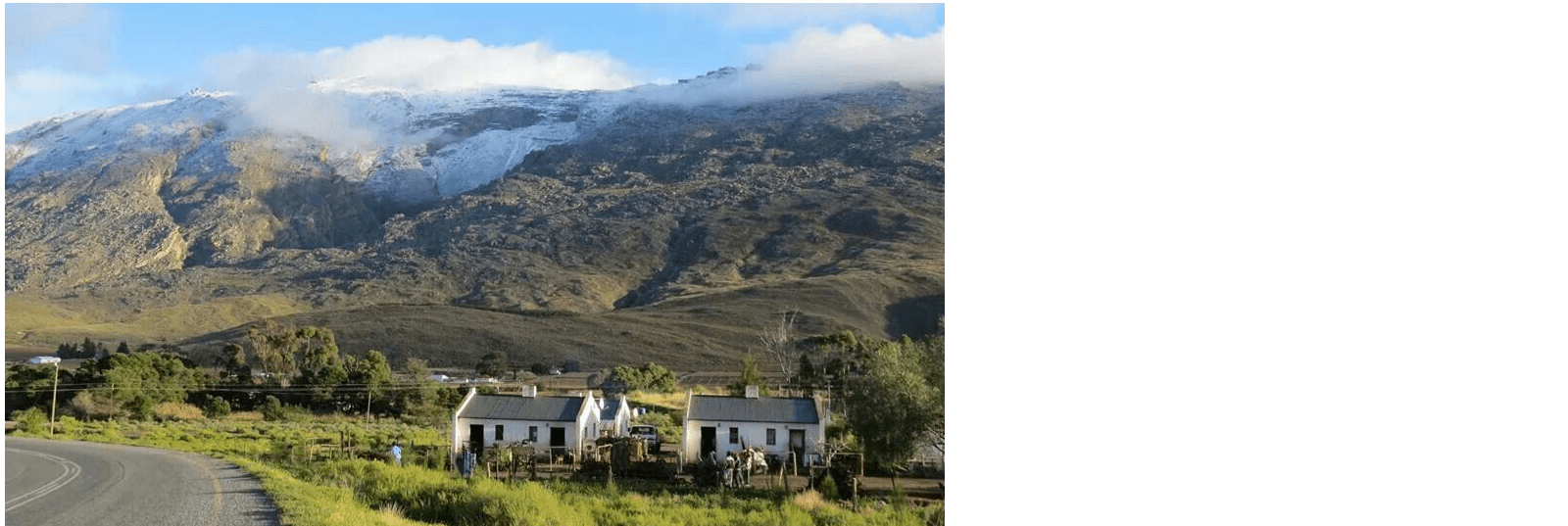History of De Doorns
- Province; Western Cape
- Coordinates; 33°29′S 19°41′E
- Area; 7.6 km2
- District; Cape Winelands
- Municipality; Breede Valley
The Origin of the Name
The name originates from a farm called “De Doorns boven aan de Hex Rivier,” meaning “The thorns on the upper Hex River”.” This name dates back to at least 1725. In 1819, the area was declared a sub-district (drosty) of Tulbagh, and by 1822, the farm had become the seat of the De Doorns drosty. The region, once a wilderness full of wild game as evidenced by San Bushmen rock paintings, saw its first pioneer farmer, Janz van Hoeting, in the 1700s.
By the end of that century, six farms had been established, each with a beautiful “Cape Dutch” homestead. Over time, these farms were divided into at least 150 smaller ones. The farm Clovelly is notably where the story of the Fair Ghost of the Hex River began.
The Arrival of the Railway
In 1875, the farm was purchased for the construction of a railway station by the Cape Government Railways. The railway line reached De Doorns by 1877, leading to the development of a small settlement around the station. This project, one of the most challenging in South Africa’s history, required the construction of two tunnels, extreme curves, and managing a steep gradient of 1:31.
Trains needed to reduce their length and weight at Touws River to handle the descent into Worcester. The station became a stop on the line from Cape Town to Touws River and then to Kimberley. In 1989, the line was reconstructed, shortening its length and adding more tunnels. The hamlet of De Doorns developed around the station, gaining a management board in 1933 and municipal status in 1951.

The Economy of De Doorns
The area around De Doorns became known for its table grape production, thriving due to the transport infrastructure. Grapes from this region are exported worldwide, making agriculture the backbone of the local economy. The rail link also played a crucial role during the Second Boer War (1889-1902), with stone blockhouses built to defend the railway line, some of which still stand today. De Doorns remains a key supplier of table grapes in South Africa.
The postcode for De Doorns is 6875
WEATHER IN DE DOORNS TODAY
all listings in de doorns
Things to do and see in De Doorns
Useful Numbers
- Police: 023 356 4020
- Municipality;023 348 2600
- Traffic department:023 356 3006
- Fire: 023 348 9060/023 342 2430
- Municipal Services Support Centre: 023 348 8000
- Ambulance:10177 Sozo Medical Rescue Montagu -023 614 2628
- Post office;023 356 2436
- Library:023 356 2700
- Clinic 19 Wilger St 023 356 2642
- Pharmacy; Hex-Kem Pharmacy-023 356 2348
- SPCA: Aquila Safari Animal Rescue Centre Touws River – 021 430 7260
- Schools: Hoërskool Hexvallei Hex Valley High School-023 356 2229
Hexvallei Secondary School-023 312 1056
Sibabalwe Primary School-023 356 3546
F.J. Conradie Primary School-023 356-3250
Van Cutsem Combined School-023 3562797 - Tourism: 023 356 2041



